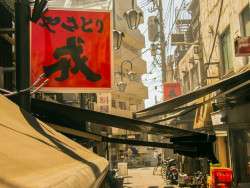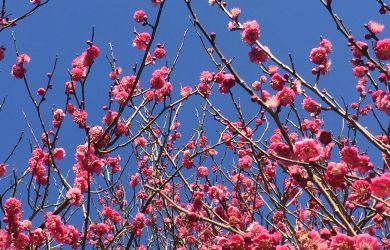
October 10, 2008
Yufuin
Hot springs and mountain climbing await in this slice of Kyushu
By Metropolis
Originally published on metropolis.co.jp on October 2008

Photos by Ry Beville
The wispy columns of steam that twist up from hot springs all over the lush valley seem to grow thicker, whiter, more inviting with the crisp autumn air. Whether you approach it by car or train, Yufuin seems to promise a kind of restorative calm elusive in so many resort areas. This little town in Kyushu’s Oita Prefecture rarely reneges on that promise.
Yufuin is known nationally for these hot springs, and while commercial development over the last ten years has changed the appearance of some of its quaint streets, the small-town atmosphere endures. Tourism accounts for much of the economy, but farming and small industry still thrive. Friendly locals keep the standard service businesses running smoothly, and arts and crafts—especially pottery—have become a mainstay. Yufuin’s population is only slightly over 10,000, but more than 3 million tourists visit annually, with increasing numbers coming from overseas.

Photo by Ry Beville
The town, together with adjoining hamlets Tsukahara and Yunohira, accounts for the second-greatest volume of hot-spring water tapped in all of Japan. Some of this fills a few of the remaining public baths, but most goes to tourist accommodations. Your options are particularly varied between the types of facilities available and the price range. Cheap hotels and guesthouses start as low as ¥6,500, while swank ryokan like the luxurious Murata can be several tens of thousands of yen.
If you are going to journey all the way to Kyushu, pony up a little extra money for a nice ryokan; you won’t be sorry. The food will be exquisite and the ambience something to remember. Some places, like Sabitei, even allow guests to bring small dogs. The best are those with rotenburo (open-air baths), and quite a few have detached buildings with their own private baths. At Ichizen, the facilities even include private rotenburo. Warabino and a few others offer all this and views of the towering Yufudake, also known as Mt Yufu.
Although most serious climbers do not consider Yufu a premier mountaineering spot, a guide published by The Fukuda Club designated it one of Japan’s top 200 climbs. With a peak at slightly more than 1,500 meters, it’s not too ambitious, either. Much of the path up is wooded, rocky and somewhat overgrown, but once you are on the grassy, wind-swept slopes above the tree line, the view of the valley is expansive and remarkably beautiful—assuming you miss the evening fog.

Photo by Ry Beville
For those who would rather stay off their legs when not soaking them, there are tours of the town by horse carriage. For a more private ride, hire one of the many rickshaw drivers posted outside the station and at other points around town. But rely on the rickshaws too much for transportation, and you are likely to miss the dozens of novelty shops that line the main strip and backstreets that stretch toward the base of Mt Yufu. Admittedly, many of these places offer your standard tourist kitsch, but there are ample numbers of shops with handcrafted goods, glasswork, clothing and decorative pottery.
Galleries have sprung up in abundance around the valley, due in no small part to tourism. Street corners have signposts directing you to nearby galleries and museums, and some ryokan even have their own showrooms. Most of the venues contain the works of lesser-known artists, and much of what you see is for sale. But one big surprise is the Marc Chagall Yufuin Kinrin-ko Museum. As you might expect, the artist’s best works are not on display, but the gallery is small and intimate, making the paintings all the more impressive. It’s not unusual to find that you have the place all to yourself. When you’ve finished browsing, relax at the downstairs café that looks out across the waters of Kinrin-ko.
Although small and seemingly unremarkable at first glance, the lake is fed by a hot spring. In cooler weather conditions—especially autumn—mist and steam dance up from the still surface, providing a romantic atmosphere for an evening stroll.
On your way in and out of the region, consider taking the special Yufuin no Mori express from Hakata station in Fukuoka. It is a gorgeous luxury train with special dining options, as well as box seats for parties of three or four. There are special windows, too, for viewing the gorgeous scenery of the countryside. Instead of driving, why not kick back and take everything in? That is, after all, what you came for.
Late October or early November is a great time to visit Yufuin, when maples around the onsen pools will be dressed in bright autumn colors. There are a number of daily flights from Haneda with all the major carriers, including Skymark. The Fukuoka airport is only a few stops away from Hakata station by subway. From there, consider the Yufuin no Mori express (http://tinyurl.com/kyushu). Accommodations include the Murata (www.sansou-murata.com), Sabitei (www.sabitei-shosen.com), Ichizen (www.oyado-ichizen.com) and Warabino (www.qs-net.com/warabino). Many onsen offer affordable day rates if you’d like to drop in for a quick soak. If climbing Mt Yufu, take gloves and a jacket, as the air gets chilly above the tree line. For details on the Marc Chagall Yufuin Kinrin-ko Museum, see www.chagall-museum.com. Contact the local tourism board for further info (www.yufuin.gr.jp).







